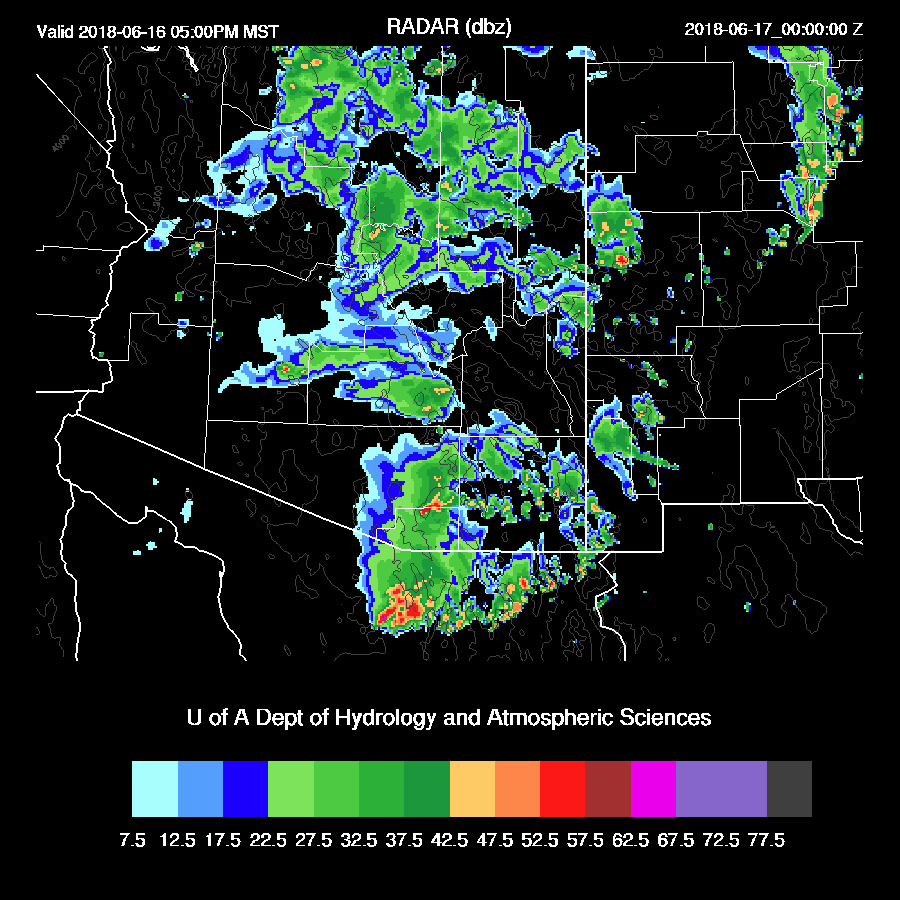Previous Forecast
Scattered storms formed over mainly over the high terrain of the eastern quarter of the state, which was similar to the WRF forecasts. The WRFNAM was too early with the very strong storms that formed just south of the border.
Initializations
NHC says Bud is a minimal tropical storm with winds at 30 knots. This is less than yesterday’s model forecasts called for, though I figured they were too strong. Bud is located about where the forecasts said it would be, over the south central Gulf of California. Model initializations of Bud look good. The closed upper trough is located a few hundred miles WSW of San Diego and is moving slowly to the east. It also appears well initialized. Clouds are widespread across the southern ½ of the state but there is some clearing over the far SE. Thus, as was the thinking yesterday, that area is likely to see more activity this afternoon. Both the 6Z WRFGFS and 12Z WRFNAM are struggling as they have the thickest clouds over SE Arizona rather than central Arizona. So, forecast confidence is decreased. The 6Z WRFNAM looks pretty good so that may be the go-to model run for today. IPW initializations were mainly good with only the 6Z WRFGFS having a slight wet bias. Showers and storms are ongoing across the southern ⅓ of Arizona. The 12Z WRFNAM did a poor job initializing this activity while the two 6Z runs were a bit better. There is a WRFRAP in the queue and perhaps it did better. At this point, I’ll mainly rely on the 6Z runs.
Day 1
Forecasting these tropical systems is NEVER easy. IPW is up to 33mm in Tucson and 34-35mm from Phoenix to Yuma so there is plenty of moisture around. High to very high 850mb Td air is over much of south central Arizona by mid-day. But what about CAPE? CAPE is usually limited in tropical systems and that is the case today. The exception is in far SW Arizona.
The upper trough and associated cooler air inches its way to the east during the day. Temperatures are less than -10C which will provide some steep lapse rates once it gets over the state. Steering flow is mainly weak across the state, but it’s quite good in SE Arizona with 20-25 knots thus some organization and propagation of storms is possible there.
The Tucson vertical profile doesn’t look very good for deep convection as CAPE is quite limited. However, directional and vertical shear are good, plus a 80 knot upper jet due to the proximity of the trough.
Phoenix is also lacking CAPE and surface heating. As with Tucson, the wind profile is good. Plenty of moisture so mainly showers with lifting provided by the incoming trough.
It’s hard to pin down timing and locations due to the complex situation. The best I can say is increasing shower and a few weak storms over the southern part of the state during the afternoon. The active area should be SE Arizona where it is clear now and a little CAPE is present.
Mainly light rain over much of southern Arizona this evening.
24 hour precipitation amounts are mainly light except for far southern Arizona.
Day 2
It remains wet over much of Arizona and into New Mexico with drying beginning to move into far western Arizona.
The upper trough moves across the southern part of the state during the day. Temperatures are below -10C at 500mb and provide a steeper lapse rate and larger CAPE values.
CAPE is moderate to high over much of central and SW Arizona by mid-day. There is potential for some strong storms.
So, moisture, CAPE, and weak dynamics are present. What about heating? WRF moves the thickest clouds off to the NE, so much of southern Arizona sees partly cloudy skies and some heating.
Phoenix does have moderate amounts of CAPE forecast and the profile is quite close to convecting by mid-day. The wind profile looks a bit chopped up thus storms may not be all that organized. Heavy rain seems to be the main threat if convection does form.
Quite of bit of deep convection develops over the southeastern ⅓ of the state by mid afternoon, including the lower elevations.
By later in the afternoon a broken line of storms moves through SE Arizona.
Tucson could see some strong storms with very heavy rain later tomorrow afternoon.
Storms move rapidly to the east and are mainly into NM by sunset.
More or less, the various model runs have the heaviest precipitation in western NM but parts of SE Arizona may see over an inch. This particular model shows 1.4” at KTUS, but don’t bet the farm on it. 
